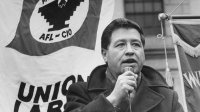Incorporating Lessons on Activism During Hispanic Heritage Month
Teaching students about key people and events in Hispanic Americans’ fight for equality is a good way to mark this observance.
Your content has been saved!
Go to My Saved Content.While there is always value in bringing diverse voices and experiences into the classroom, Hispanic Heritage Month, celebrated September 15–October 15, offers teachers an opportunity to focus on the many contributions of Hispanic Americans with students.
Hispanic Civil Rights Movements
During Hispanic Heritage Month, students are often given opportunities to read texts by or about Hispanic authors. While that is a great way to start exposing students to the lives and experiences of Hispanic Americans, teaching students about Hispanic civil rights movements offers a deeper learning opportunity.
Not only does exploring these movements allow students to learn about influential Hispanic leaders, but also it allows them to develop an understanding of a particular time in history and the lasting impact of activism. Further, teaching about Hispanic civil rights movements can help students understand how they can continue to recognize and address social justice issues going forward.
The 1968 East L.A. School Walkouts
In 1968, public schools in East Los Angeles served a student body that was predominantly Mexican American. However, these students did not have access to educational opportunities that reflected and valued their cultures and identities. In the spring of 1968, thousands of public school students walked out of their East Los Angeles classrooms to protest the unequal educational opportunities for Mexican American students. The series of protests became known as the East L.A. school walkouts.
Upper elementary students can explore the movement for educational equity by watching LA Walkouts. The PBS Learning Media video provides an opportunity to introduce the events surrounding the walkouts and begin a class discussion about their impact. Students hear directly from teacher and walkout organizer Sal Castro as he reflects on the experiences that led him to seek better conditions for a new generation of students. Teachers can also use the United Way Greater Los Angeles article “The Walkout—How a Student Movement in 1968 Changed School Forever” as a resource for additional information on the movement and multiple photos from the event.
Middle and high school students can dig deeper into the events leading up to and surrounding the L.A. walkouts with Facing History & Ourselves’ free two-day lesson plan and optional extension activities: The 1968 East LA School Walkouts. Students spend the first day considering the impact of learning only a “single story” in school. The second day is spent examining the L.A. walkout participants’ various demands and how each strived to create a more inclusive education for Mexican American students.
Essential questions addressed:
- What does an education that honors all students look and feel like?
- Why is it important for students to have such an education?
Sí, Se Puede
During the 1960s and 1970s, the United Farm Workers organized to bring attention to the harsh and unsafe working conditions that California migrant farmworkers were facing. The movement was led by Mexican American civil rights activists César Chávez and Dolores Huerta.
Upper elementary students can explore the movement with a free ELA unit from Fishtank Learning (where I work): Sí, Se Puede. The unit is centered around La Causa: The Migrant Farmworkers’ Story, by Dana Catharine de Ruiz and Richard Larios, and includes supplemental videos, articles, and photos. Students address reading, writing, and speaking standards throughout the unit as they describe the conditions that farmworkers faced, Chávez and Huerta as leaders, and the lasting legacy of the farmworkers’ movement.
Essential questions addressed:
- What was life like for migrant farmworkers in the 1960s? What barriers did they face in order to obtain better working conditions and wages?
- What were some of the key moments in the migrant farmworkers’ fight for justice?
- Who were César Chávez and Dolores Huerta? What strategies did they use to make meaningful, long-lasting change?
- How did the farmworkers use different types of nonviolent protest to educate the public and push for change?
Middle and high school students can explore the topic with the National Endowment for the Humanities’ free lesson plan: “Sí, Se Puede!”: Chávez, Huerta, and the UFW. The lesson and extension activities center around video and discussion questions covering the Bracero Program, César Chávez and the United Farm Workers, Dolores Huerta, and the overall Hispanic fight for civil rights.
Essential questions addressed:
- Why was the United Farm Workers union formed?
- How did the political circumstances of the time influence how farmworkers organized?
- What did César Chávez and Dolores Huerta do for civil rights in the United States?
- How do the Hispanic labor and civil rights movements compare with other labor and civil rights movements in U.S. history?
- What is the legacy of the UFW in U.S. history?
Hispanic Heritage Month is certainly a time to focus on these stories, but it should not be the only opportunity students have to learn about these topics. Teachers can continually infuse diverse narratives and experiences into their curriculum and help students understand the value of expanding their understanding of the world around them.
If you are interested in additional movements and key moments in the history of Hispanic civil rights, the Library of Congress has created a resource guide of civil rights cases and events that includes links to many additional resources for learning more.
